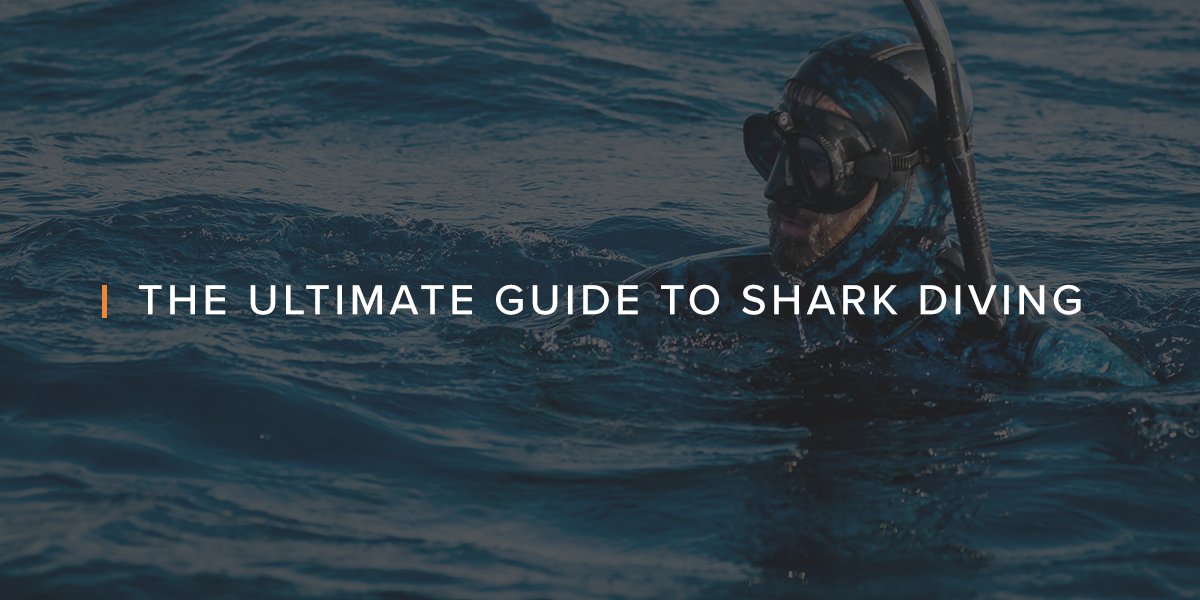Swimming with Sharks | The Ultimate Guide
CLICK HERE FOR THE ULTIMATE GUIDE
The Ultimate Guide to Shark Diving
- Why Cageless Shark Diving?
- What Do You Need To Go Shark Diving?
- How Dangerous is Shark Diving?
- What is a Shark Anyway?
- So, Why are Sharks Important in the Animal Kingdom?
- What Kind of Sharks Will I See?
- Who Can Go Shark Diving?
- Where to go Shark Diving?
- How to Shark Dive
- Can I go Shark Diving?
- How Do I Choose a Shark Diving Guide?
- Is Shark Diving Ethical?
- Appendix
What the heck do silicone rings, watch bands and sharks have in common? Not a lot... unless you spend a weekend with the Groove Life Adventure Team!
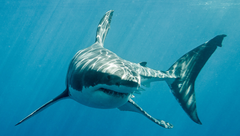 One of the ultimate values at Groove Life is to inspire people to adventure by sharing our own stories of life on the wild side! If we don’t have stories to tell we can’t inspire you. If we aren’t inspiring you, we don’t even want to think about how we’d feel when we’re done selling rings and watch bands.
One of the ultimate values at Groove Life is to inspire people to adventure by sharing our own stories of life on the wild side! If we don’t have stories to tell we can’t inspire you. If we aren’t inspiring you, we don’t even want to think about how we’d feel when we’re done selling rings and watch bands.
So, in order to inspire adventure the Groove Way, we went diving with sharks!
We went to show you that if we can do it…YOU CAN TOO!
To help you on your own Shark Diving adventure, we wrote the Ultimate Guide to Shark Diving.
So, when you decide to take the plunge and swim with sharks, don’t worry! We did all the work for you! We researched our options, compared prices, picked out the prime locations, found the best coaches in the world (well, that was mostly so we wouldn’t die) and learned a whole bunch about sharks and cageless shark diving.
Then, we swam with sharks.
And here it is… the “Ultimate Guide to Shark Diving.” so get ready to “dive in” and plan your own trip! Get off the couch, get to the location of your choice (as long as it’s in this ultimate guide) and live the fantastic adventure of Cageless Shark Diving.
Why Cageless Shark Diving?

Sure, you can go hop in a cage and enjoy the comfort of knowing there are impenetrable steel bars protecting you from losing a limb and becoming shark bait, but that’s no fun! We want you to feel the thrill of a shark slapping you in the chest with his tail fin (like we did) as he circles you to let you know he’s the King of the Sea!
If you’re hesitating, we understand! If you are like most sane people, your logical first question is “Why would someone ever want to go shark diving? And without a CAGE?!?”
Swimming around with sharks without a cage sounds like a death wish, right?
Could it be the enticing draw of the hundreds of razor-sharp teeth in the shark’s  mouth? Or maybe it is the thrill of shadowy shapes rising from the deep to snatch piec
mouth? Or maybe it is the thrill of shadowy shapes rising from the deep to snatch piec
es of dead fish from the waters around you?
Yes. Yes, it is all of these things and more.
What most people don’t know - and what we learned on our shark diving adventure is - despite our preconceived notions about these magnificent fish, sharks are not “out to get you.” As you can expect, it’s easy for your heart rate to rise as you hop in a boat, headed out into the ocean with a plan to meet a shark... or five.
As our Groove adventure team hit the water, it only took us a few seconds beneath the blue waves to realize that this beautiful world was something we could only begin to appreciate. Fish and other sea creatures swam peacefully in the ocean waters, and the great sharks swam up to bump gently against our legs, allowing us to get close enough to touch their leathery skin. These sharks were created by God with a specific, essential purpose, and we were honored to be able to take a few moments and appreciate them for the fantastic creatures they are.
So, why we, or anyone for that matter, want to go shark diving?
An experience like this opens your eyes. You will no longer see the ocean waves without imagining the beautiful creatures that live in the depths. You will not be able to hear the word “shark” without remembering the ones you were able to meet face-to-face. You will not be able to “fear” them as you did before. Instead, you will feel respect for the role they play in nature.
Yes, shark diving is intimidating, but so is mountain climbing, running a marathon, traveling the world, and even loving other people. The experiences you remember most are often those that required the most courage. Plus, most cageless shark diving costs less than $300 so it's a fantastic adventure for a very low cost!
If you ever have the opportunity to slip beneath the waves and live out this thrilling adventure for yourself, we encourage you to take it! As cliche as it sounds, the old saying is true. You only live once - and, the way we see it, shark diving in the wild ocean is the eye-opening kind of moment that makes life worth living.
What Do You Need to go Shark Diving?
You now have a healthy respect for these incredible creatures called sharks, and you have a long list of locations to choose from when you plan your shark diving experience!
Now, it’s time to prepare yourself for the life-changing experience that lies ahead.
You may be thinking, “What do I need to shark dive?” As you may expect, there are a few shark diving essentials you will need to obtain before you leap into the underwater home of the sharks.
Are you ready to dive in? Let’s get packing!
1. You need an ocean.
This may sound elementary, but you actually need to choose a very specific area of water… you can’t just shark dive in any old cove! You’ve read our list of locations that are ideal for diving and the types of sharks you could see there, but there are a few things you’ll want to look for when you choose a shark diving destination: clear, moving water is a prime habitat for sharks. We chose Jupiter, Florida because it has beautiful, clear water, especially for the area, and is a popular place for sharks because the Gulf Stream Current flows just a couple of miles off the coast! This makes Jupiter a prime location to see sharks and lots of other marine life in what the Shark Addicts say is ‘one of the most highly diversified marine ecosystems in the world.’
2. You need a crazy-awesome guide.
Shark diving is a fantastic experience, but diving into a shark habitat is like climbing a live volcano. You need to have a healthy respect for the situation and make sure you’re traveling with an expert.
Make sure you choose a guide that knows what he or she is doing! Our experience with Apex Encounters in Jupiter was a fantastic experience and lots of the credit goes to our fantastic guide. He was very experienced and professional He made sure we knew as much as possible about the sharks we might encounter and had a healthy respect for these gigantic predators, and he was always ready to hear any concern we might have.
Make sure you choose a guide with a fantastic personality! Shark diving can be an intimidating experience and you want someone who knows what they are doing, but also can put you at ease with a great sense of humor! This is going to be an unforgettable memory and you want to experience it with someone who will make every moment fun and exciting!
3. You need a boat.
While some of you might be in a condition to swim several miles out to sea - looking at you Chuck Norris - the rest of us need a bit of transportation. When selecting a boat, you’ll want to make sure it is nice and large with plenty of space to walk around. If you’re thinking about taking your lake weekends pontoon out to sea, think again! You need to take a boat that is specifically designed for the ocean… and it doesn’t hurt if it looks pretty cool as well!
4. You need money.
We know… all the best things in life are going to cost you. Thankfully, shark diving is one of the less-expensive adventures you’ll find! Our shark adventure in Jupiter cost only $200 per person for a half-day experience! We were blown away by the affordability of such a professional and high-quality experience! Other shark diving adventures could be a little higher, depending on if you need to purchase a flight as well, or how much time you will be spending on the water. We found many incredible shark diving options in the range of $150-$300 for a half-day of shark diving.
5. You need Chum.
Some of you may remember the fast food restaurant “Chum Bucket” from Spongebob? Well, if you’re hoping to meet some sharks, you may need a chum bucket of your own. Chum is basically a piece of a fish that you take with you into the water to lure the sharks in close. Yep… you lure them in with the smell of blood. Can you feel the adrenaline kicking in yet? This is only the beginning of the adventure.
6. You definitely need a healthy dose of courage.
You are getting ready to dive into ocean infested waters, hoping to meet the legendary Bruce from Jaws, or any number of sharks, in the depths! Yep, you’d better make sure you bring a whole lot of courage along because you’re going to need it!
For real though… it is important to have the courage to stay calm and remain peaceful when you meet the sharks. You are entering their home, so, as our guide cheerfully commanded us, “channel your karate kid” and interact peacefully but with the strength of confidence as you encounter these beautiful predators… even if your insides are screaming “freak out and swim away!” You’ll soon find that the peace of the sharks will calm your spirit so you can interact with them comfortably.
“Wait… that’s it? What about gear?”
Yep, that’s absolutely all you need. No need to buy gear, books, licenses, or permits because nothing else is necessary! Your shark diving guides will have everything you need to make your trip a success!
How Dangerous is Shark Diving?
-
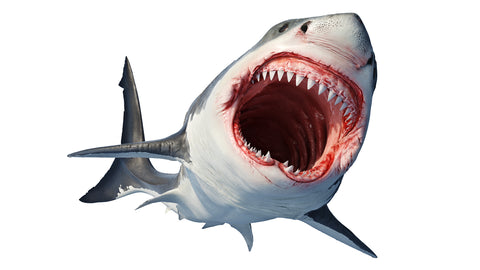
Galeophobia! Man, even the word sounds scary, doesn’t it?
The first question you will probably ask if you consider going on a shark diving adventure will have something to do with shark bites. It keeps many wanna-be’s away from shark diving. Sadly, hundreds of people will miss out on this epic adventure because of galeophobia.
Of course, we don’t want you to miss out on the fantastic moment we experienced, so here’s the truth about the possibility of a shark bite while diving with sharks.
A shark attack was a ridiculous notion until the hit movie “Jaws.”
It was 1975 and movie-goers were flocking to the theater to see the brand new proclaimed epic film about a shark terrorizing a small village. Prior to that movie, “JAWS” was not a household term. In those days, sharks were not viewed as great predators slowly skimming the shallow waters searching for their next unsuspecting summer vacationer.
-
Now, let’s get this straight. It’s wise to be cautious when you are blindly swimming the murky waters. Most sharks do have many rows of razor blades in their mouth used to rip apart their prey with jaws that have the ability to exert 3,700 pounds of pressure per square inch. I know that number doesn’t mean much to you or to me, but, in contrast, a human exerts 150-200 pounds when eating a medium-rare ribeye. Lions - the kings of the jungle and the top of the food chain - chomp down with about 1,000 pounds PSI. A 3,700 pound PSI bite is worth a little caution.
-
We are just not on their hit list…
With that said, it was helpful for us to know, and probably for you as well, that if a shark were to be scanning a menu in their favorite shark restaurant, humans would not even make the list. Sharks are simply not interested in indiscriminately chomping down on the closest set of human legs it can find in the shallows. Most species would much rather munch on scallops, mollusks, fish, and… wait for it… YES, sharks would even rather have other sharks for dinner than humans.
Although our emotions scream to the contrary, a human being is more likely to be the victim of a rabid wild hyena with zombie deer disease than being attacked by a shark! (Well, that may be a bit of an exaggeration.) However, it is documented that operating motorcycles, cars, and airplanes, along with many other dangerous everyday activities, is more dangerous than shark diving.
-
Some Sharks are More Dangerous than Others
Although shark diving is of miniscule risk, we learned on our adventure that there are some species of sharks more aggressive toward humans than others. There is a huge range of opinions on which shark species is most aggressive. Here is a list of the 10 most dangerous sharks in no specific order.
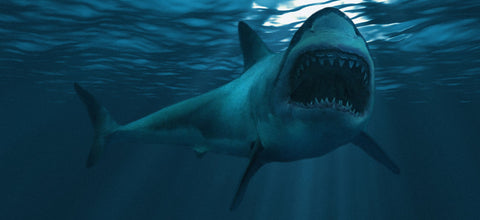
-
-
-
Dangerous Sharks
- The White Shark (AKA Great White, AKA “Jaws”)
- The Bull Shark
- The Tiger Shark
- The Shortfin Mako
- The Oceanic White Tip
- The Bronze Whaler Shark
- The Blue Shark
- The Sand Tiger Shark
- The Blacktip Shark
- The Hammerhead Shark
Alternatively, there are some shark species that are very friendly and interactive with human beings hanging out in their neck of the woods...er… cove. We found that the lemon shark almost enjoyed our presence. One friendly lemon actually bumped a team member’s leg with his nose and rubbed his entire body along my leg like you’d expect from a pet cat. If you are a beginner on a shark diving adventure, these are the ones you are glad to see according to leisurepro.com, an online SCUBA magazine.
-
Friendly Sharks
- The Nurse Shark
- The Leopard Shark
- The Angel Shark
- The Whale Shark
- The Lemon Shark
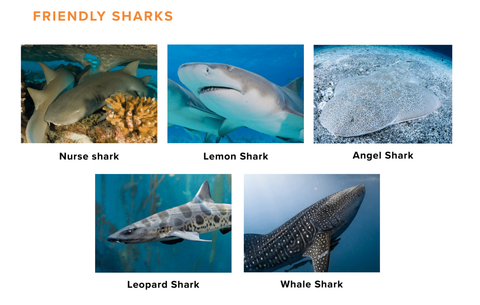
Our conclusion is that shark diving has minimal risk in return for a huge reward, as is true with most great adventure experiences. As a matter of fact, one of the most important factors a shark’s interacts interaction with a human is the underwater diver’s behavior in the presence of these gorgeous sea creatures.
We’ll talk more about that later!
-
What is a Shark Anyway?
So, what is a shark exactly, and what is its purpose in creation?
There are so many misconceptions about sharks and their role in nature that we decided to play “mythbusters” today and tell you the raw truth about sharks and their purpose here on earth.
First, did you know that sharks are fish, while whales and dolphins are actually mammals? Sharks are, according to Sharks-World, “cartilaginous fish” and are known for a skeleton made of cartilage and connective tissue instead of bone. Other cartilaginous fish species include rays, skates, and sawfish… so sharks are in good company!
Here are a few fun facts you may not know about sharks:
Fun fact #1: Shark scales are actually…. teeth (as if they didn’t have enough already!)During our shark dive, we noticed that the sharks appear sleek and smooth, even up close! Surprisingly though, their body “armor” is, according to NOAA Fisheries, made up of many tiny “placoid scales” or “dermal denticles” which means they are basically “tiny teeth.” These scales are smooth when brushed in the direction of nose to tail, but can feel like sandpaper if stroked the wrong direction! The dermal denticles actually help the shark swim silently, by lowering the amount of friction in the water as they move through it.
Fun fact #2: Not all sharks are the same.It may surprise you that there are actually over 440 different species of sharks in the world today! These sharks have different characteristics, from tail structure and body shape to number of teeth and level of aggression, but they all were created for the same purpose… more on that later!
Fun Fact #3: Shark teeth are unlimited. Like a buffet… but more intense.When you think of sharks, you probably picture an open mouth full of teeth! The truth is, teeth are one of the most essential parts of a shark body, and without them, it would probably die pretty quickly. The shark was created with the unique ability to be able to grow unlimited amounts of teeth. When a front tooth falls out, another tooth moves up from a back row to replace it, so in a lifetime, sharks will have an average of 30,000 teeth, total! The shark tooth fairy must have a busy job.
Fun Fact #4: Sharks rarely close their eyes. (no wonder they look so stressed!)The only time sharks close their eyes is when they are feeding or having an encounter with another shark! Some types of sharks are unable to stop moving because the movement provides them with oxygen. According to the Florida Museum, other sharks do have an external respiratory opening known as a spiracle that keeps a continuous flow of water moving over the gills so the shark is able to rest and breathe at the same time. We think sharks always look stressed out because they don’t get enough sleep… but that could just be our imagination.
Fun Fact #5: Sharks and tonic immobility.Sharks sometimes seem to be invincible, but tonic immobility is their kryptonite! When a shark is gently turned upside down in the water, it goes into a trance-like state that does not allow it to move. It is uncertain whether the trance is a defense mechanism or not. When the shark has turned right-side-up again, it is able to swim and function as if nothing had happened. Tonic immobility is a great tool for researchers because they can use it to care for or study a live shark without causing any harm, but other sea creatures can use this trance against a shark that is caught off guard!
Fun Fact #6: Sharks can sense the electrical field of other animals.According to a study by Nature International Journal of Science, Sharks, along with rays, skates, and a few other fish species, can actually sense tiny changes in environmental electrical fields and use these to find small animals that they cannot see. This skill comes in handy when sharks are hunting for animals that are hidden in the sand! It’s a good thing we didn’t grow up playing with sharks… they would win flashlight tag any day.
Fun Fact #7: Sharks never sleep.Imagine a life without sleep... It sounds like a pretty horrifying thought! For sharks, though, this is simply normal life. Sharks are one of the few animals that never sleep! They are able to enter a trance-like state of rest during which parts of their brain shut off while their body keeps moving. This restful state gives sharks the energy they need to keep going. This sounds exhausting to us but they must still feel rested, because they live an average of 20-30 years… that is a long time for an animal!
Now we’re going to move on to the purpose of sharks in creation.
Sometimes it is easy to see these gigantic predators only as a threat and something to fear, based on the movie Jaws and the occasional “shark attack” story one might hear. The truth is, sharks play a highly valuable role in the circle of life, and our world would be a very different place without them.
-
So, why are sharks important in the animal kingdom?
Sharks are an apex predator, which means they have few natural predators in the marine ecosystem. If marine life was a game of chess, sharks would be the Queen piece, because she is the one that holds the most power and when you lose the queen, the game starts to go downhill fast.
If sharks did not exist, other species of fish and marine life would start to multiply beyond control, and these species would extinguish the life below them or start to eat all of the base food sources, causing a huge imbalance in the ocean. According to Save the Sharks, sharks easily switch between food sources depending on availability, which leads to a natural balance in the underwater world. In reefs where there are no sharks, entire species are absent because sharks were not present to preserve balance. In fact, according to Shark Savers, if sharks were to grow scarce on a larger scale, entire species could go extinct and natural environments would vanish as other species grew in abundance! The absence of sharks would drastically change the way we live!
Can you believe that ONE type of animal is so important on the earth? It’s pretty crazy to think about.
When we take a step back and look at the world as we know it, we soon feel completely in awe of the power of the Creator of the earth. Everything was designed in a perfect balance and every living thing created with a beautiful purpose. Sharks are beautiful yet terrible, sometimes frightening because of their predatorial role in nature, but we respect them because they are irreplaceable.
As we move into a closer look at different types of sharks and what makes them unique, we hope you are able to appreciate these fascinating fish and keep in mind that they fill a vital role in nature.
When we went free diving with sharks, we were blown away by the majesty and authority in the water. We want you to experience the same feeling of awe when you go shark diving after reading this guide.
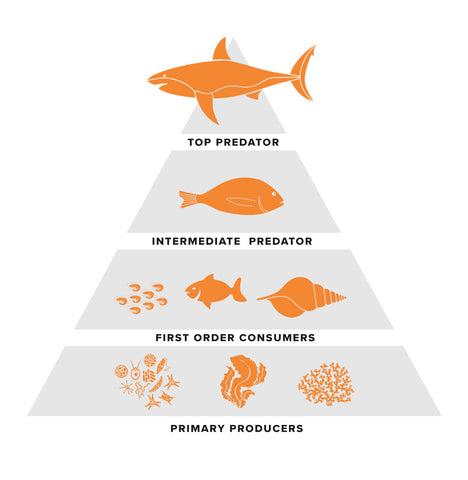
-
What Kind of Sharks Will I See?
Now that we’ve educated you on the uniqueness of sharks, you might be wondering exactly what kind of sharks you could see beneath the big blue waves on your shark dive. Well, depending on what part of the world you choose to visit for your adventure, there could be hundreds of different species you might encounter. However, we want to tell you more about a few of the most common types of sharks you’ll see off the coastlines of North America.
The Lemon Shark
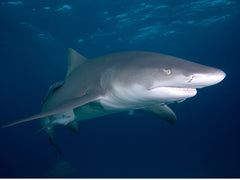 We’re starting with the Groove Life crowd favorite from our shark dive off the coast of Juniper, Florida - the Lemon Shark! Not only were these sharks incredibly interactive, but they were beautiful to watch as they cut through the waters around us with grace. Lemon Sharks are very distinctive in their coloring and actually get their name from the pale, yellow-brown coloring of their skin.
We’re starting with the Groove Life crowd favorite from our shark dive off the coast of Juniper, Florida - the Lemon Shark! Not only were these sharks incredibly interactive, but they were beautiful to watch as they cut through the waters around us with grace. Lemon Sharks are very distinctive in their coloring and actually get their name from the pale, yellow-brown coloring of their skin. You might be able to see Lemon Sharks from your balcony while you’re visiting Florida for vacation. This is because they generally stay in shallow, warm water, and don’t usually swim deeper than about 300 feet. This makes them easier to spot from high up in your condo on a clear day.
The shallow waters of bays, coral waters, and river mouths are prime real estate for Lemon Sharks. This is where they can find a smorgasbord of marine life to feed on, including catfish, crabs, and crawfish.
If, like us, you find yourself up close and personal with a Lemon Shark during your shark dive, you’ll be able to identify it by looking at the dorsal fins (those tell-tale fins that stick out of the water, which almost immediately cause the theme song of Jaws to trigger in your head). Both the front and back dorsal fins on a Lemon Shark are almost the exact same size.
Lemon Sharks are considered to be gentle and non-aggressive towards humans, which is why they are so often seen during shark dives. In fact, there has never been a report of a fatality caused by a Lemon Shark. You could even say they avoid conflict.
The Nurse Shark
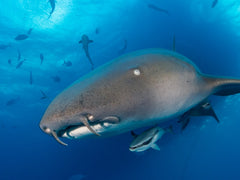 Nurse Sharks are another amazing shark to spot under the sea during an open water shark dive. They travel in groups and can often be found “snuggling” together in underwater caves. Believe it or not, their sluggish and docile behavior has earned them the nickname “couch potatoes of the ocean.”
Nurse Sharks are another amazing shark to spot under the sea during an open water shark dive. They travel in groups and can often be found “snuggling” together in underwater caves. Believe it or not, their sluggish and docile behavior has earned them the nickname “couch potatoes of the ocean.”Nurse Sharks spend most of their time on the bottom of the ocean just hanging out and living their best lives in tropical waters near coastal shelves and reefs. When they do get up and start moving, they usually like to hang out in shallow waters to find food.
Because they are so casual and carefree, Nurse Sharks are some of the best to interact with during a shark dive. You can get up close and personal with them and still be safe. In fact, there has never been a report of a fatal attack from a Nurse Shark.
The Sandbar Shark
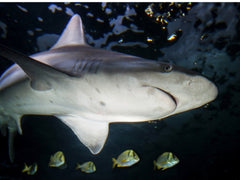 Another amazing shark to interact with during your shark dive is the Sandbar Shark. They can most often be found on the sandy bottoms of shallow warm waters, and you may even see them in your nearby harbor.
Another amazing shark to interact with during your shark dive is the Sandbar Shark. They can most often be found on the sandy bottoms of shallow warm waters, and you may even see them in your nearby harbor.
You can spot a Sandbar Shark by their very high dorsal fin and very long pectoral fins. Their bodies are a little on the hefty side and their snouts are shorter than most of their brother sharks.
These sharks are considered to be safe around people and give divers a thrilling experience every time!The Hammerhead Shark
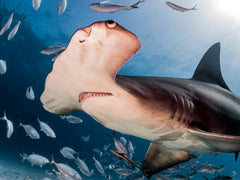 The hammerhead was our favorite shark we spotted on our cageless shark diving adventure.
The hammerhead was our favorite shark we spotted on our cageless shark diving adventure.
This beauty is one of the most easily identifiable sharks in the ocean because of the obvious shape of its head. Conveniently, the eyes of the Hammerhead are located on the outside edges of the “hammer,” which gives them the unique ability to have a vertical 360-degree view! While they can see everything above and below them, they can’t actually see much in front of them.Hammerhead Sharks can be found all over the world and stay in warm shallow waters. And while they're cruising around in those shallow waters, they often pick up a little something extra - a sunkissed glow. That’s right! Your friendly Hammerhead is one of the very few animals who can get a tan from the sun! Bet you didn’t know that.
Hammerhead Sharks are night hunters and often feed off of bottom-dwelling marine life such as shrimp, squid, and small fish because of their smaller mouths. These sharks are also known for their cannibalism. That’s right - they’re not big on the buddy system, and they aren’t above making lunch out of a smaller Hammerhead that gets in the way.
Hammerhead Sharks are generally safe around humans, especially those on shark dives in open waters. Conveniently, they give warnings if they’re headed toward an attack. When you’re on your shark dive with trained professional divers, they’ll know how to keep you safe if you encounter a Hammerhead Shark.
The Reef Shark
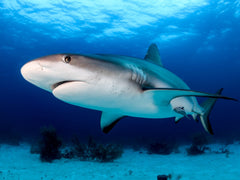 There are several variations of these stunning creatures. They are one of the smaller sharks you might see on a shark dive. And though they may be small, they are mighty and are considered to be one of the most important species on planet Earth!
There are several variations of these stunning creatures. They are one of the smaller sharks you might see on a shark dive. And though they may be small, they are mighty and are considered to be one of the most important species on planet Earth!
They are apex predators that mostly dwell in warm waters near coral reefs. Because they sit at the top of the food chain on the reefs, Reef Sharks shift the spatial habitat of their prey, which in turn alters the feeding strategy of other marine life. So, in truth, these sharks indirectly maintain and control the health of the habitats of coral reefs. Wow!
Reef Sharks are uniquely colored and sport a white to light yellow color on one side, and a grey-brown to dark-grey color on the other side. Their snout is short and rounded, and they have bigger eyes than most sharks - all the better to see you with, my friend!
Since Reef Sharks live near coral reefs, you’ll mostly find them in the Caribbean or other waters like the Indian and Pacific Oceans, or in Japanese Waters and the Mediterranean Sea.
Reef Sharks can be a threat to divers near coral reefs, and most experts consider them to be moderately dangerous to humans. For the most part, reported Reef Shark attacks have been non-fatal and typically happen when the shark has felt threatened.
The Bull Shark
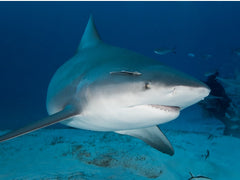 The Bull Shark is one of the more aggressive sharks swimming in the deep blue sea. But that’s not necessarily why they’re so well known. North Americans know about these sharks because they are one of the few types of sharks that can live in both saltwater and freshwater! That means you could see them during your shark dive in the ocean, or even swimming up the Mississippi River. After all, they like to show up in places you’d least expect them!
The Bull Shark is one of the more aggressive sharks swimming in the deep blue sea. But that’s not necessarily why they’re so well known. North Americans know about these sharks because they are one of the few types of sharks that can live in both saltwater and freshwater! That means you could see them during your shark dive in the ocean, or even swimming up the Mississippi River. After all, they like to show up in places you’d least expect them! Believe it or not, in 1938 two fisherman caught a bull shark on the Mississippi river all the way up in Illinois. The bull had wandered 1,750 miles up the great Mississippi! The famous bull shark of Alton, Illinois was over 5 feet long and weighed in at 84 pounds.
You’ll be able to identify a Bull Shark by their wide, stocky bodies and broad, flat snouts, resembling that of a bull, which is where they get their name. This shark has two dorsal fins, of which the second is noticeably smaller. The skin of a Bull Shark is grey and their bellies are white - not that you’ll be rolling one over for a full examination any time soon.
They tend to stay in warm, moderately deep water and migrate around the ocean looking for food. While they are one of three shark species that are known to attack humans unprovoked, attacks by Bull Sharks are very rare. We just don’t necessarily recommend spending too much time hanging out with them to test this stat.
-
Who Can Go Shark Diving?
Before our shark diving adventure trip, this is the fact that most surprised us. Anyone who is physically able and has a little bit of money (just a little bit) can go shark diving! ANYONE!
There is no training, no certifications, no regulations, and no limitations on who can dive! You don’t have to be able to SCUBA or deep water dive. You don’t need to plan out five days of instruction prior to your dive. And you really don’t need much money at all (we’ll talk more about that later.)
Seriously, a plane ticket or drive to a shark diving destination and a couple hundred dollars will get you in the water with some of the best dive guides in the world! No heavy workouts six months leading up to the dive. No special equipment or expensive gear required (that will be provided by your shark diving guide.) It’s the easiest adventure we’ve ever taken and it will be for you too!
Physical Fitness
-
There are no official guidelines for physical fitness to go on shark dives, however, the activity is a little bit more strenuous than a snorkeling dive. The dive guide you choose may have their own restrictions. You will be informed of those when you book your trip.
Heart Problems
When you go in for the first time and see your first shark(s), you heart rate rises and your breathing is restricted. Therefore, people with heart conditions are obviously not good candidates for this adventure.
Motion Sickness
The trip out to the dive sites can be bumpy boat rides on the ocean, so if you have problems with motion sickness make sure to start a day before the dive with motion sickness pills. These can be purchased over-the-counter at any drug store. Dramamine or Bonine are two of the most popular brands, however, consult your doctor for the best brand for you. Both are great brands for motion sickness pills. These come in regular and non-drowsy versions. Be aware that the regular version may cause significant drowsiness. If you have extreme issues with motion sickness, you might want to consider a different adventure.
Comfort in the Ocean
The ability to swim and feel comfortable in saltwater with regular oceanic activity is helpful. Swimming in the ocean is much different from swimming in a pool or lake. The constant current requires a bit more physical exertion to keep things stable. Snorkeling for the first time can complicate the experience. Some experience snorkeling or practicing with snorkel gear is a good idea. Grab some cheap snorkel gear and take an afternoon in a deep pool to get a feel for breathing underwater.
Ability to Follow Instructions from the Professional
The number one most important requirement for a successful shark diving adventure is an ability to precisely follow every instruction given to you by your trusted shark diving guide! Although shark diving is relatively safe, SHARKS STILL BITE! Your dive guide knows how to keep you safe when you are unable to think clearly underwater. He will instruct you when he sees you acting like SHARK BAIT. It is extremely important for you to follow his instructions all the way, right away and with a happy heart (as we tell our kids.) Trust us, the best way for you to get back to shore is to trust the person who took you off-shore.
-
Can You Go Shark Diving? Quick Checklist:
Is Shark Diving right for you? Let's find out!
- I have no current health problems or personal history of heart problems.
- I do not have any problems with extreme motion sickness.
- I am comfortable swimming in deep waters.
- I have some experience swimming in the ocean.
- I have some experience or am willing to practice with snorkeling gear.
- I am willing to precisely follow directions from my dive guide while on the water.
Where to Go Shark Diving
Now that you know all about sharks, let’s talk about where you can shark dive!
First of all, you need to know that in this guide we are focusing on cageless shark diving. There are countless opportunities for diving in a cage, but we love the freedom and unexpected aspect of free diving with sharks and observing the natural underwater home of sharks up close that we were able to experience on our adventure!!
There are so many breathtaking locations where you can see different kinds of species, and sometimes the decision of where to shark dive can be overwhelming! First, make sure you evaluate your top priorities. Are you hoping to catch a glimpse of a big, lumbering whale shark, or would you rather see some tiger sharks up close? Are sharks the only animals you want to see, or are you hoping to meet some dolphins and a few turtles as well?
No two places offer the same kind of shark diving experience, which is why we are including a list of the most fantastic places to go diving with sharks, along with some information on what kind of animals you are likely to meet during your adventure!
Keep in mind, there is always some level of risk when you interact with these beautiful predators in their ocean home. Don’t worry though, according to National Geographic, you’re actually statistically more likely to be harmed by a lightning strike than a shark attack. In fact, sharks are often misunderstood and do not intend to attack humans. Instead, they are often actually shy like a wild kitten, unfamiliar with humans and not likely to see them as potential prey. Doesn’t that sound a lot less frightening?
That being said, be sure to take care to listen to instructions and learn all you can about the sharks before you take on an adventure of this nature! It is important to make sure you are diving with an expert that knows how to handle sharks and can give you confidence and guide you through the process. We will share some of our recommended guides and shark experts with you in a later chapter!
Now, to learn more about the best shark diving adventure locations worldwide, and what kind of animals you will likely see beneath the waves!
1. Hale'iwa, Hawai'i on the North Shore of O'ahu
 Hawaii is often thought of as a paradise on earth. What could be better than shark diving in the crystal clear waters of the Hawaiian islands? More than 40 different shark species live in the Hawaiian oceans, along with many other beautiful animals. Near O’ahu, you’re likely to see meet dolphins, humpback whales, and turtles, as well as sandbar, Galapagos, tiger, and hammerhead sharks!
Hawaii is often thought of as a paradise on earth. What could be better than shark diving in the crystal clear waters of the Hawaiian islands? More than 40 different shark species live in the Hawaiian oceans, along with many other beautiful animals. Near O’ahu, you’re likely to see meet dolphins, humpback whales, and turtles, as well as sandbar, Galapagos, tiger, and hammerhead sharks!
In addition to an exploration of the Hawaiian waters, you will also learn about sharks and gain a better understanding of their role in nature. This location is special. It’s not too often that humpback whales are visible, but they migrate to Hawaii between December and January. So there is a chance for you to see these beautiful creatures.
2. Protea Banks, South Africa
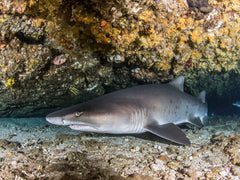 Protea Banks is home to many species of sharks, as well as one of the richest grounds of Tuna that you can find! Bull sharks often hunt for Tuna in the area, so you are likely to meet one when diving here!
Protea Banks is home to many species of sharks, as well as one of the richest grounds of Tuna that you can find! Bull sharks often hunt for Tuna in the area, so you are likely to meet one when diving here!
Scalloped Hammerhead and Blacktip sharks also frequent these waters. If you come at the right time of year, between May and November, you might catch a glimpse of 100-200 Ragged Tooth Sharks when they come to the caves at Northern Pinnacle for breeding season!
3. Diving off Honshu Island, Japan
 When you think of shark diving, you probably picture Hawaii or the Bahamas. But Japan actually has an impressive variety of diving trips you won’t want to miss! These shark diving experiences will introduce you to sharks that you aren’t likely to see anywhere else, including blotchy swell sharks, Japanese horn sharks, banded hound sharks, and several species of rays! Plus, you can enjoy experiencing the beautiful, rich culture of Japan while you’re in the area.
When you think of shark diving, you probably picture Hawaii or the Bahamas. But Japan actually has an impressive variety of diving trips you won’t want to miss! These shark diving experiences will introduce you to sharks that you aren’t likely to see anywhere else, including blotchy swell sharks, Japanese horn sharks, banded hound sharks, and several species of rays! Plus, you can enjoy experiencing the beautiful, rich culture of Japan while you’re in the area.
4. Cornwall, United Kingdom
 During the early summer months of mid-May to early July, the unique and very odd basking sharks - the second largest shark in the world, known for their massive, gaping mouths - can be seen off the shores of Cornwall, England. If you participate in a shark diving tour in Cornwall, you can catch a glimpse of pods of dolphins, Cornish penguins, fin whale, leatherback turtles, sunfish, and diving gannets, not to mention a few seals as well! Don’t forget to grab some Cornish ice cream before you leave!
During the early summer months of mid-May to early July, the unique and very odd basking sharks - the second largest shark in the world, known for their massive, gaping mouths - can be seen off the shores of Cornwall, England. If you participate in a shark diving tour in Cornwall, you can catch a glimpse of pods of dolphins, Cornish penguins, fin whale, leatherback turtles, sunfish, and diving gannets, not to mention a few seals as well! Don’t forget to grab some Cornish ice cream before you leave!
5. Whale Sharks in Australia
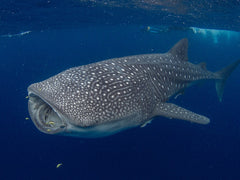 In Australia, when you’re finished admiring local kangaroo and platypus, you have the rare opportunity to meet the largest fish in the sea… the whale shark! These gigantic, spotted sharks prefer to feed on plankton and can weigh around 20.6 tons! They are docile and friendly, which makes them a good shark to see in a free dive. Be sure to plan your trip for spring when the whale sharks migrate to Australia, so you don’t miss diving with them and some turtles, rays, and other small fish!
In Australia, when you’re finished admiring local kangaroo and platypus, you have the rare opportunity to meet the largest fish in the sea… the whale shark! These gigantic, spotted sharks prefer to feed on plankton and can weigh around 20.6 tons! They are docile and friendly, which makes them a good shark to see in a free dive. Be sure to plan your trip for spring when the whale sharks migrate to Australia, so you don’t miss diving with them and some turtles, rays, and other small fish!
6. Basking Sharks in Scotland
 If you missed the gaping-mouthed basking sharks in Cornwall, you can catch them in Scotland as well! Scotland is also home to otter, seals, whales, common and bottlenose dolphins, puffins, fingals and more, so you can meet a variety of animals on your shark dive! Scotland is a gorgeous vacation destination as well, and some tours offer 3-7 week tours for those who are interested in getting to see the more reclusive species of wildlife, both on land and in the water.
If you missed the gaping-mouthed basking sharks in Cornwall, you can catch them in Scotland as well! Scotland is also home to otter, seals, whales, common and bottlenose dolphins, puffins, fingals and more, so you can meet a variety of animals on your shark dive! Scotland is a gorgeous vacation destination as well, and some tours offer 3-7 week tours for those who are interested in getting to see the more reclusive species of wildlife, both on land and in the water.
7. The Bahamas
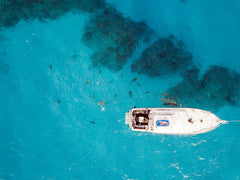 The Bahamas are often thought of as a beautiful beach vacation destination, but a whole new adventure awaits for ambitious travelers who want to see what lies beneath the waves! The Bahamas are home to the tiger shark, Caribbean reef sharks, hammerheads, lemon sharks, loggerhead turtles, nurse sharks and more! Tiger Beach specifically features crystal clear water, perfect to see local tiger sharks up close!
The Bahamas are often thought of as a beautiful beach vacation destination, but a whole new adventure awaits for ambitious travelers who want to see what lies beneath the waves! The Bahamas are home to the tiger shark, Caribbean reef sharks, hammerheads, lemon sharks, loggerhead turtles, nurse sharks and more! Tiger Beach specifically features crystal clear water, perfect to see local tiger sharks up close!
8. Jupiter, Florida
 Jupiter, Florida is a beautiful travel destination and home to manatees, which makes it a fun place to visit! If you choose to shark dive in Jupiter, you will likely have the chance to meet dolphins and sea turtles in addition to tiger, bull, hammerhead, and lemon sharks. Jupiter is also a favorite location for sandbars and duskies, which you aren’t likely to see in many other locations. The Groove Team chose Jupiter as our shark diving destination because of their amazingly skilled divers and fantastic location, and we weren't disappointed!
Jupiter, Florida is a beautiful travel destination and home to manatees, which makes it a fun place to visit! If you choose to shark dive in Jupiter, you will likely have the chance to meet dolphins and sea turtles in addition to tiger, bull, hammerhead, and lemon sharks. Jupiter is also a favorite location for sandbars and duskies, which you aren’t likely to see in many other locations. The Groove Team chose Jupiter as our shark diving destination because of their amazingly skilled divers and fantastic location, and we weren't disappointed!
9. Southern California
 If you take a boat about three miles into the waves of Southern California, you’ll likely meet blue, mako, and hammerhead sharks. You also might have the unique opportunity to see white sharks, as well as threshers and leopards. Southern California is also home to the humpback whale and the angel shark, both of which would be fantastic to be able to see at close range! You might even meet a sea lion or a few seals while you’re exploring beneath the waves.
If you take a boat about three miles into the waves of Southern California, you’ll likely meet blue, mako, and hammerhead sharks. You also might have the unique opportunity to see white sharks, as well as threshers and leopards. Southern California is also home to the humpback whale and the angel shark, both of which would be fantastic to be able to see at close range! You might even meet a sea lion or a few seals while you’re exploring beneath the waves.
10. Galapagos Islands
 The Galapagos Islands are known for having a diverse and unique amount of wildlife, and its marine life is no exception! You can view and interact with a variety of sharks, rays, and even an occasional sea lion while snorkeling in the shallower water. During your shark dive, you have the opportunity to meet Galapagos sharks, whale sharks, hammerheads and silky sharks, as well as other animals. While you’re there, keep an eye out for pink Iguanas, on land of course!
The Galapagos Islands are known for having a diverse and unique amount of wildlife, and its marine life is no exception! You can view and interact with a variety of sharks, rays, and even an occasional sea lion while snorkeling in the shallower water. During your shark dive, you have the opportunity to meet Galapagos sharks, whale sharks, hammerheads and silky sharks, as well as other animals. While you’re there, keep an eye out for pink Iguanas, on land of course!
We hope this list was helpful to you as you sort through the pros and cons of all the different locations have to offer. We recommend that you start with a location that is a little closer to home and see how you like the experience! You may find that you enjoy shark diving so much - like we did - that you simply cannot stop looking for new experiences to try and a variety of species of fish to see!
Also, make sure you take into consideration what time of year is best for the particular experience you are looking for. Sharks and whales are often migratory and a little picky about the weather. You’ll be much more likely to see some of these animals if you pick a time of year that they prefer to come up closer to the surface to meet you!
As you make the decision of where to shark dive, have fun researching the different types of animals you might see so you can recognize them when they appear! Don’t forget to relax and enjoy your time in the water! Shark diving is an unforgettable experience and you’ll likely find yourself wishing yourself back in the water the minute you leave!
How to Shark Dive
There’s no way you can know what it’s like under the surface of the ocean with sharks swimming around you until you are there! Our biggest concern when we went shark diving was that we had no clue how to act when we dipped under the surface for the first time.
We’re only a little bit experienced in cageless shark diving, so we thought we’d lean on the sage advice of expert shark diver and owner of Shark Addicts in Jupiter, Florida, Chris Cameron, for advice on how to shark dive.
Groove: Chris, what are some things a diver needs to be aware of in order to go shark diving.
Chris: The first thing a person needs to know is that as soon as they enter the water they completely lose their auditory senses. You have to understand that in order to keep yourself safe. Unlike hunting, sports and other outdoor activities, you can’t hear what’s going on around you. Complete silence is awesome! You’re other senses are heightened and it feels like you enter into a new realm, but at the same time, the sense that’s gone is gone and you have to be aware of what you lose in order to compensate.
Groove: Why would that be important to know when you are shark diving?
Chris: Well, these animals are super intelligent. They understand depth perception and water conditions and they stay just outside the range of visibility. It seems impossible that an animal that’s 13-feet long and 1500 pounds could sneak up on you. How could something as big as a small boat appear out of nowhere? Using their natural understanding of the environment: that’s how they do it. And without that auditory sense it can happen quickly. I’ve been diving before and all of a sudden the hair on the back of my neck stood up and I turned around and there she was, clipping the top of my head. The dramatic shadow sends chills up your spine. It’s a very humbling feeling knowing you just got ninja’d by a 1500-pound fish.
Groove: So, do the sharks see you as a threat and how do you manage that?
Chris: As we tell all of our customers, it is important to remember that you are a guest when you are in the ocean. You are in their home and we are just lucky enough to share the water with them. It’s a life-changing experience, but it’s their domain. Let them be in charge of your dive. Follow their lead.
Groove: If I get scared in the water, what should I do?
Chris: Remember that the key to shark diving is to move as slowly as possible. If you’re hands and feet are flailing around you’re just ringing the dinner bell. Slow circular movements help the sharks feel comfortable and to see you as a visitor instead of their next meal. Slow movements and slow breathing also slows down your heart rate and helps you stay in that Zen state. That is the sweet spot for shark diving. The main thing to remember is to take deep slow breaths and keep your movements as slow as possible and you’ll be fine.
Groove: What if a shark charges me?
Chris: We call that a redirect and only encourage that as a last resort. When that shark is getting too close you can just take your hand and gently nudge her nose in another direction and she’ll just swim right off and mind her own business. Other than that we ask that you not touch the shark for any reason.
Groove: What else do we need to know?
Chris: That’s about it. Just trust your dive guides and do exactly what they ask you to do. Always keep your eyes on the sharks. They know when you are looking at them and when you leave yourself vulnerable. If you have any questions or equipment malfunctions, always take care of that at the boat, not while you are out in the water. When you stop paying attention to these animals, you are giving them more control. Other than that, let’s go shark diving!
Can I Go Shark Diving?
- Be ready to lose your normal senses under the water.
- Respect the sharks... treat the ocean like their home and you are a guest.
- Stay calm, and keep your body language steady and relaxed.
- In the very rare case of feeling threatened, gently redirect the shark by nudging her nose.
- Trust your guides and respect their instructions.
How do I Choose a Shark Diving Guide?
We could never stress enough how important it was for us to make sure we had the perfect shark diving guide when we went on our epic adventure. I mean, if you are going to intentionally swim with dangerous ocean creatures and actually work hard to get them to come hang out with you, it’s a pretty big deal that you have someone who knows what the heck they are doing by your side.
At the risk of being repetition, we want to lay out ten questions you want to ask if you are paying someone to help you put your life on the line by jumping off the side of a boat and into a swarm of sharks.
Ten Questions to Ask Your Potential Shark Diving Guide
- How long have you been paid to take people on shark dives?
- What type of sharks do you think we will see?
- Have you ever been in a situation where you thought you might die?
- How did you handle that situation?
- What kind of boat do you use for shark diving?
- What gear do you provide for my shark diving trip?
- How often do you see sharks on your dives?
- Do you offer any refunds if we do not see any sharks?
- Do you provide videos of my shark dive?
- Do I need to bring snacks or lunch on my shark dive?
Is Shark Diving Ethical?
Before we went shark diving, we were asking the same question. As a matter of fact, we discussed the ethical issues of shark diving with our chosen shark diving guide, Chris Cameron, from Shark Addicts in Jupiter, FL.
Chris educated us on the issue of responsible shark diving and we decided to share his thoughts with you here.
Shark diving and shark fishing have almost done a complete 180 in popularity since the 1970’s when JAWS ruled the summer blockbuster spot. In recent years, the explosion of social media and sharing of viral content, productions like Discovery channels Shark Week, and a more conservation centered public opinion on wildlife has all led to the exploration of just how close we can safely get to sharks in the wild.
In Florida alone, the revenue generated by shark diving is more than 200 times that of the national fin trade. The fin trade is the practice of catching sharks, cutting off their fins while they are alive, and discarding the animal back into the water to drown. This practice is done to provide shark fins for shark fin soup, a delicacy and symbol of prosperity in several asian cultures. By placing a higher economic value on the animal alive than dead, shark diving drives the protection of this irreplaceable apex species through its economic value, something commonly overlooked in conservation.
Multiple studies have taken place to measure the effects of chumming on migratory patterns. To date, no substantial evidence has been provided to support claims either way. We do see conditioning in sharks behavior and a relaxed state from sharks when they approach divers. This direct clarification between predator and prey allows us to share the water alongside sharks safely day after day.
-
-
Shark Feeding vs. Chumming
When we hopped on a plane to go shark diving in Jupiter, Florida, we had no idea what chumming even means, much less what the difference is between feeding and chumming. We quickly learned that chum is cut up dead fish and that chumming means that shark divers are throwing that fish in the water or dropping it down from the boat in a basket in order to lure the sharks to the boat. This is considered a much less behavior altering method of luring sharks than feeding, which would be humans giving the sharks the bait out of their hands.
Chumming is a legal form of luring sharks and has no noticeable effect on a shark’s behavior or migration patterns over time. Chumming is successful because it creates a scent in the water that attracts the fish to the boat. It does not cause a dependency on humans, as feeding would. Responsible shark divers, like us, are very careful to have minimal impact on the shark’s environment.
-
Our Conclusion on the Ethics of Shark Diving
The benefits of shark diving far outweigh the negative effects. Shark divers are passionate about protecting the sharks and ensuring that they thrive in the future. Responsible shark divers care about these beautiful creatives and work hard to raise awareness of the positive role they play in creation. The highlight of a shark dive for our fearless guide Chris Cameron is any moment that he can remove a hook from the mouth of a friendly shark and save the fish from the danger that a sharp chunk of metal often creates.
Another goal of responsible shark divers is to restore unity between humans and sharks. During our shark dive we learned through experience that, as people are exposed to sharks and begin to understand that sharks are not blood-thirsty monsters out to get them, they will be committed to protecting these amazing creatures. Now that is something that will be good for us all.
Now Get Out There and Dive with Some Sharks
We hope this “Ultimate Guide to Shark Diving” has encouraged you to get off the couch and plan a shark diving adventure! Trust us, it’s worth the time, effort and the little bit of money it might cost you! Heck, all you have to do is stop drinking lattes for like… a month!
So, grab your courage, pick your destination, and find a guide because it’s time to dive into the most exciting adventure of your life!
Appendix
- The least dangerous shark species. Leisurepro.com
- Why are we afraid of sharks? There's a Scientific Explanation. National Geographic
- Shark Anatomy. Sharks-World
- 12 Shark Facts That May Surprise You. NOAA Fisheries
- Sharks FAQ. Florida Museum
- Molecular basis of ancestral vertebrate electroreception. Nature: International Journal of Science
- Sharks, The Apex Predators. Save the Sharks
- Sharks' Role in the Ocean. Shark Savers
- Face your Fears: Six of the Best Shark Diving Trips. The Telegraph
- Shark Diving Locations. Dive Worldwide
- Shark Diving Locations:
